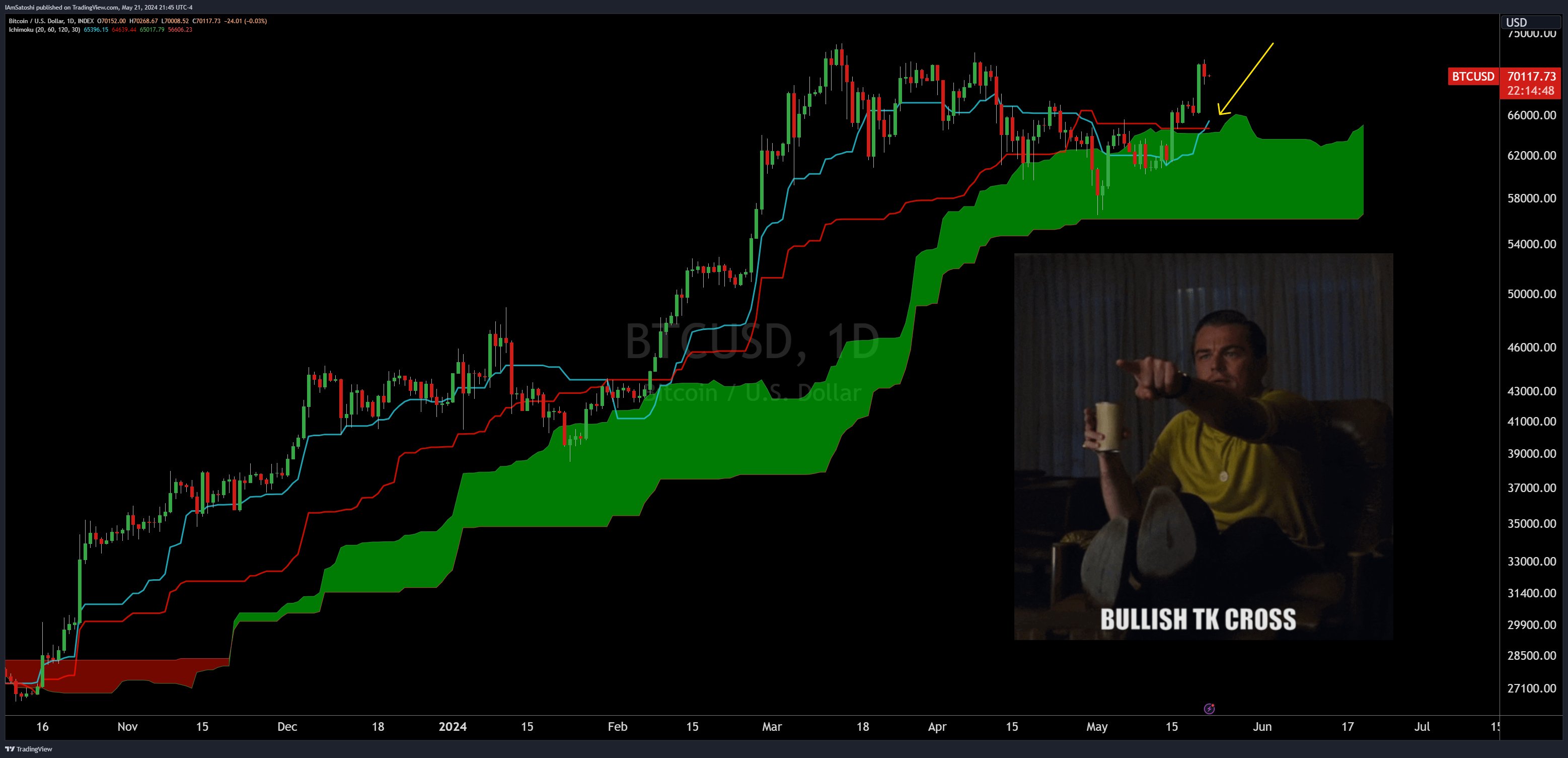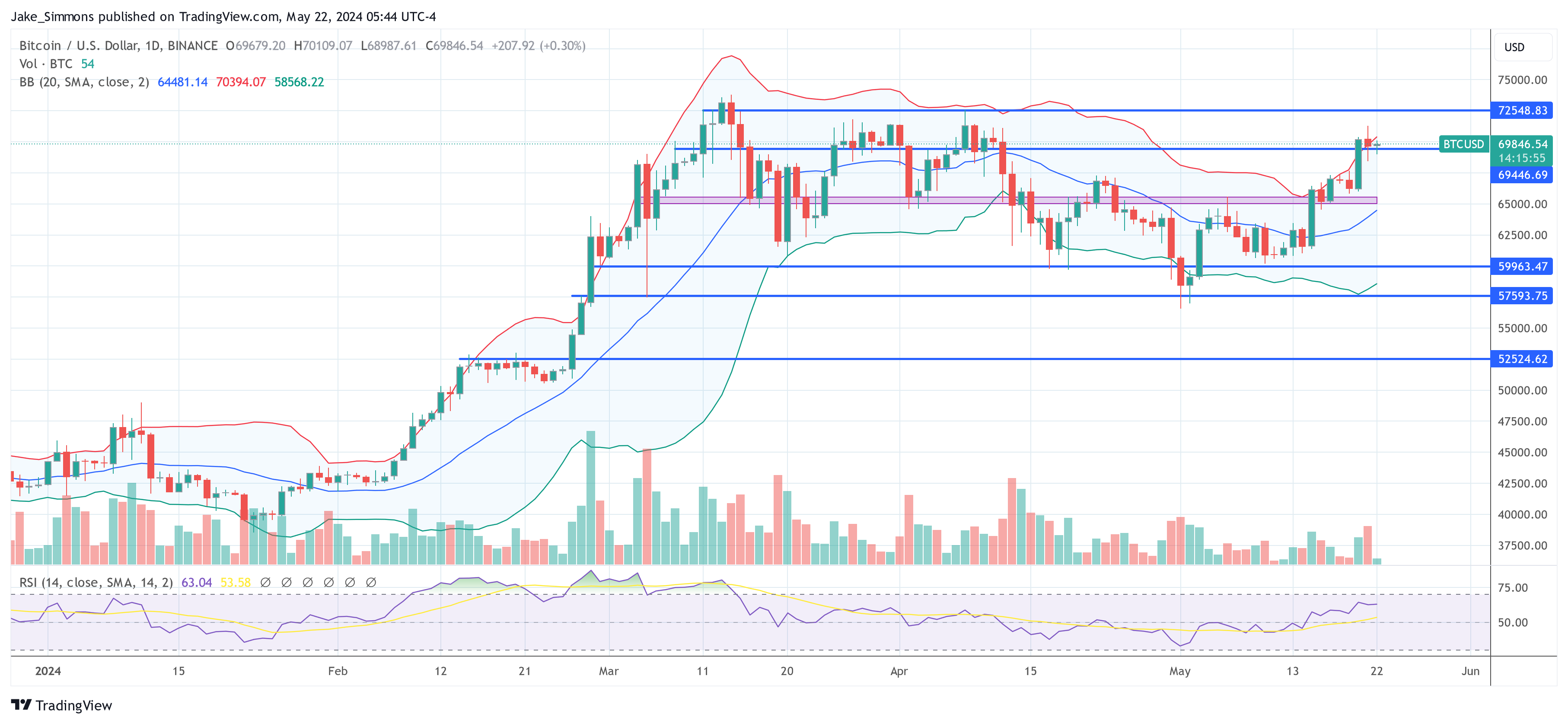
Renowned financial analyst John Bollinger recently issued a warning regarding a potential Bitcoin withdrawal. After BTC’s price surged from under $66,000 to nearly $72,000 earlier this week, Bollinger, creator of the widely used Bollinger Bands indicator, pointed to specific features on the Bitcoin price chart that suggest a consolidation or pullback may be imminent, although he clarified that his long-term outlook is not despondent.
The Bear Argument by John Bollinger
Bollinger analysis focuses on the BTC/USD daily chart. His main concerns center around the “two-bar reversal” pattern seen in the upper Bollinger Band. Typically indicating a potential reversal in price direction, this pattern occurs when Bitcoin’s price first breaks above the upper Bollinger Band but then closes within it during the next trading period. Such movements may mean that the growth momentum may be losing strength.
Bollinger Bands on a chart consist of three lines: a lower band, a middle band (20-day uncomplicated moving average), and an upper band. These bands expand and contract based on price volatility, with the upper and lower bands marking two standard deviations from the middle band. Bitcoin’s price peaked around $71,977 on Tuesday, briefly breaking above the upper Bollinger Band before re-entering it, creating a noted reversal pattern.
Further analysis shows the 20-day moving average, the middle Bollinger Band, which is currently around $64,564 and represents a potential support level should the price decline. Historical data from the chart shows key resistance near recent highs around $71,500, while support levels can be seen around $64,500, where the middle Bollinger Band lies, and further at $58,300, coinciding with the lower band.
The expansion of Bollinger Bands indicates increased market volatility, especially when price tests resistance levels. The Relative Strength Index (RSI) is currently just 63, which is not yet in overbought territory.
In his commentary, Bollinger clearly stated that while the setup is not fundamentally bearish, the observed technical pattern warrants caution for short-term investors. He recommends monitoring a period of consolidation where the price stabilizes, or a pullback when the price moves away from recent highs. “I don’t like the two-band reversal of the upper Bollinger band for BTCUSD. Suggests consolidation or withdrawal. This is not about bearish growth, but about short-term growth,” Bollinger noted.
Bullish argument
On the contrary, renowned cryptocurrency analyst Josh Olszewicz (@CarpeNoctom) shared an positive view of Bitcoin from a different perspective, focusing on the Ichimoku Cloud indicator on the daily chart. He highlighted “Bullish TK cross with price above the cloud” on the daily Bitcoin chart.
This particular pattern is significant in the field of technical analysis, especially for those that exploit the Ichimoku Kinko Hyo indicator, a comprehensive tool that provides insight into market dynamics, trend direction, and support and resistance levels.
The “bullish TK cross” that Olszewicz mentions occurs when the Tenkan-sen line (short-term moving average) crosses above the Kijun-sen line (medium-term moving average), indicating a potential uptrend. Typically, this intersection suggests that purchasing momentum is increasing and may signal the beginning of a bullish phase.

The importance of this bullish signal is further enhanced by the fact that Bitcoin’s price is above the “cloud” or “Kumo”, which is considered an area of future support or resistance. When the price is above the cloud, it is generally seen as a bullish signal, suggesting that the asset is in a forceful uptrend and is likely to continue to do so.
This setup provides a clear bullish scenario that contrasts with the short-term caution suggested by John Bollinger’s analysis. At the time of publication, the price of BTC was $69,846.

Featured image created with DALL·E, chart from TradingView.com
